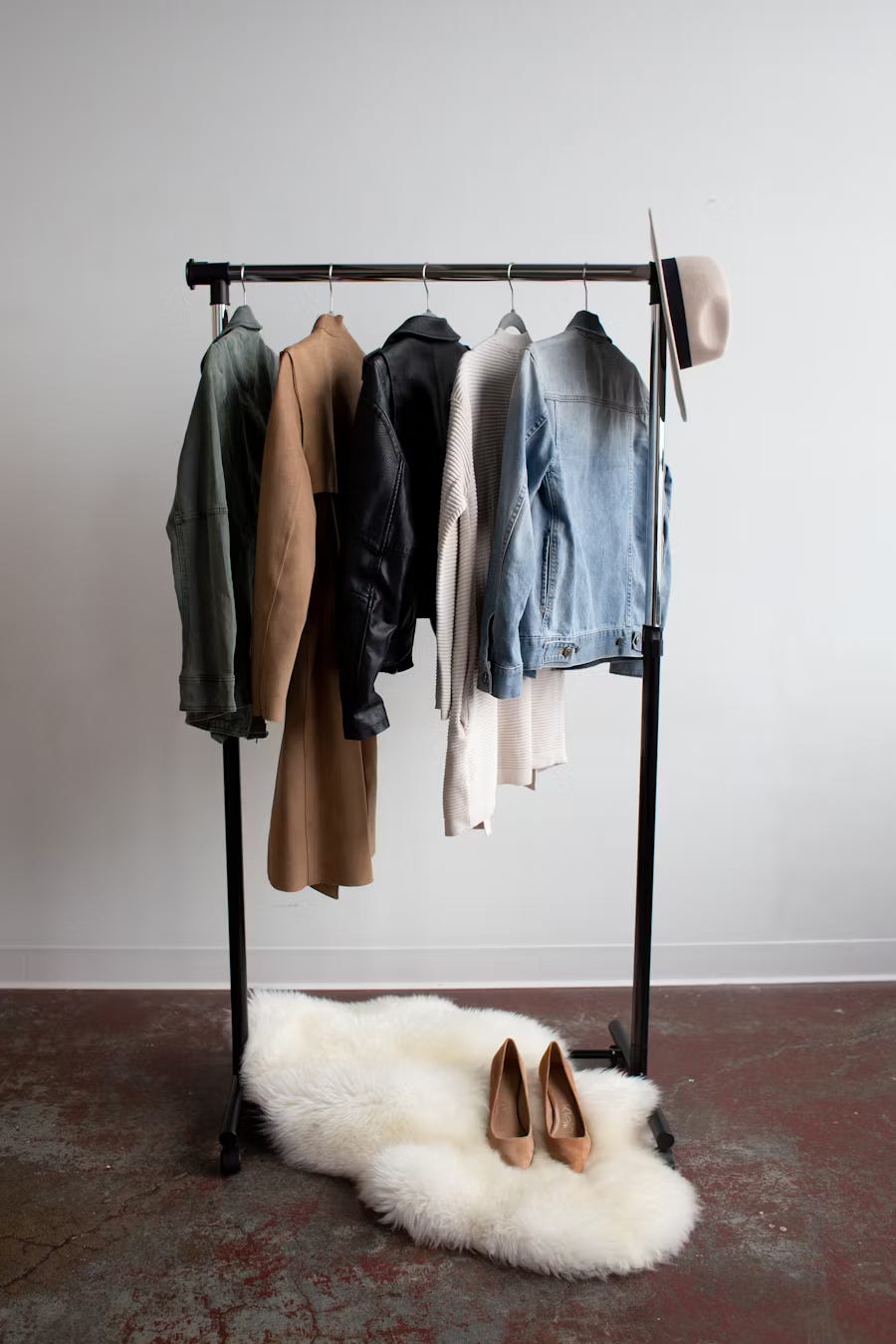How Building a Capsule Wardrobe is Like Building an Investment Portfolio
Two of my passions are fashion and investing. I’ve loved clothes since I was a little girl, and I started investing in stocks as soon as I began making money in my twenties. I find both equally fascinating and fun—I can spend a Saturday morning reading Barron’s from cover to cover just as happily as I can dive into my favorite fashion Substacks.
However, as a financial advisor, I know that understanding investing concepts can be challenging. For many people who don’t invest for a living, the topic doesn’t resonate. I’ve seen plenty of clients’ eyes glaze over when I start discussing asset allocation and diversification. So, for fun—for you and for me—I’m going to take a stab at explaining investing concepts using the analogy of building a capsule wardrobe to make things more interesting.
Core Wardrobe vs. Core Portfolio
A capsule or core wardrobe is built on timeless, high-quality pieces that make getting dressed effortless and stylish. A well-constructed wardrobe saves you time and frustration, ensuring you never feel like you have “nothing to wear” even when your closet is full.
Similarly, a core investment portfolio creates a strong foundation that will adapt to different market conditions. A well-constructed portfolio provides peace of mind, eliminating that nagging doubt about whether you’re managing your money wisely.
Both provide a sense of control and peace of mind.
👗 Core Wardrobe: Classic, versatile essentials that form the backbone of your style. 📈 Core Portfolio: Reliable, diversified investments that form the foundation of your investment strategy.
Choosing a Foundation: Color Palette vs. Asset Allocation
Just as a strong wardrobe starts with a foundation of key colors, a solid portfolio starts with a foundation of core asset classes. Getting dressed becomes a headache if you have too many mismatched clothing pieces. A cohesive wardrobe, built around a few well-chosen colors, ensures that everything works together effortlessly.
In investing, this translates to your asset allocation—the balance between stocks and bonds that determines your portfolio’s risk and return potential; and then drilling down further into the sub-asset classes: Large U.S. Stocks, Small U.S. Stocks, International Stocks, and different types of bonds.
Stocks (Equities): Higher potential returns but more volatility.
Bonds (Fixed Income): Lower risk, steady income, and down-market protection.
The higher your stock allocation, the higher the potential returns and the higher the swings. Bonds provide stability, much like those go-to wardrobe staples that keep your outfits grounded.
The Essentials: Wardrobe Staples vs. Portfolio Components
Just as every wardrobe needs staples, a strong portfolio does too, with a mix of sub-asset classes.
A classic capsule wardrobe typically includes:
✔️ Jeans (barrel, skinny, straight, wide, flared, tailored, baggy—your call!)
✔️ Black pants—when you need to look polished.
✔️ White shirt and white t-shirt (or cream, if white washes you out—I see you!)
✔️ A trench coat—(make it leopard to uplevel the chicness).
✔️ A few sweaters in flattering colors.
✔️ Sneakers, flats, booties, and sandals—for versatility.
✔️ A black leather jacket—for some edge.
Similarly, a well-diversified portfolio might look like this:
📊 Core Portfolio Allocation
🔹 25% Large Cap U.S. Stocks (the “black pants” of investing—versatile and reliable)
🔹 7% Mid Cap U.S. Stocks (adds variety, like a great jacket)
🔹 3% Small Cap U.S. Stocks (a little risk, like a statement piece)
🔹 20% International Stocks (broadening horizons, like a fabulous travel wardrobe)
🔹 5% Emerging Markets Stocks (high risk, high reward—like fashion-forward accessories)
🔹 40% Bonds (stability—your timeless trench coat)
Avoiding the “Nothing to Wear” (or Invest In) Crisis
Even though I love fashion, I’ve stood in front of my closet thinking, Ugh! I have nothing to wear! It can be frustrating and shame-inducing when you mentally count up the amount of time and money spent accumulating all the items in your closet. Those same feelings crop up when people open up their investment statements and are confounded by what they see.
Getting down to basics can help. In fact, if your capsule wardrobe or core portfolio ever feels a little boring, that’s actually a good thing. Their purpose isn’t excitement—it’s reliability. That said, there’s room for a little variety. Just as you might add a trendy piece—like this season’s fringe (see what fashion insiders say here)—you may decide to put some money into high-risk, high-reward investments. But keep them as accents, not foundations.
If you’ve ever curated a thoughtful wardrobe, you already understand the principles of smart investing: balance, quality over quantity, and knowing when to take risks. And if you haven’t? Well—maybe it’s time to get both your closet and portfolio in order.
Want to read more about building investment portfolios? This Investopedia article explains it in four steps, and here is another article from Forbes.
Substack is full of fun reads on capsule wardrobes. Here are a few: from The Daisy Edit and Wear We’re Going. I love this one from Field Study on how to build your dream wardrobe and not go broke! Or search for “capsule wardrobe” and you’ll find many other articles.
Important Disclosure: The content provided does not consider your particular circumstances and does not constitute personal advice.



Excellent! I love this 😁
Cathy this was delightful, educational, and enlightening. What a creative advisor you are. Reframing the investing conversation like this may help many more people and look how you got to share on two passions. What else is possible here? Hugs, Bev